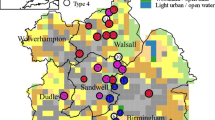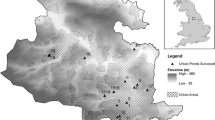Abstract
Green spaces within urban areas provide services and benefits to human populations and habitat for a variety of species. Freshwater, in the form of rivers, canals, lakes, reservoirs and ponds, is an important component of urban greenspaces. This paper focuses on ponds; and specifically ponds within urban areas. This work is timely as during 2008 ponds were designated, in the UK, as habitats of national conservation importance. Yet, while farmland ponds have received considerable attention, there has been little work on the ecology and landscape ecology of urban ponds. Ecological data was collected from 37 ponds in the Borough of Halton (northwest England) over a period of 2 years (2005–2006). The median species richness in these ponds was 28 invertebrate species and 10 macrophyte species. A highly significant correlation was observed between pond density and species richness. The relationship between the richness of different taxa varied according to scale; becoming more significant within pond clusters than within a single pond. These findings have significance for those involved in planning and managing urban environments, further strengthening the need for functional ecological connectivity in urban areas. With pressure to increase infill development, and thus raise housing density, a greater understanding of the affect of urban design on pond ecology will be of importance to urban planners and ecologists alike.



Similar content being viewed by others
References
Arntzen JW, Wallis GP (1991) Restricted gene flow in a moving hybrid zone of the newts Triturus cristatus and T. marmoratus in Western France. Evolution 45:805–826. doi:10.2307/2409691
Banks B, Laverick G (1986) Garden ponds as amphibian breeding sites in a conurbation in northeast England (Sunderland, Tyne and Wear). Herpetol J 1:44–50
Beebe TJC (1979) Habitats of British amphibians (2) suburban parks and gardens. Biol Conserv 15:241–247. doi:10.1016/0006-3207(79)90046-6
Beer AR (2003) Greenstructure and urban planning—case study. Research into Biodiversity in Domestic Gardens, Sheffield, UK. Available at http://www.map21ltd.com/COSTC11/Sheffield/sh-domest-gdns.htm. Accessed 17 March 2008
Biggs J, Whitfield M, Williams P, Fox G, Nicolet P (1998) Factors affecting the nature conservation value of ponds: results of the National Pond Survey. In: Proceedings of the ponds conference 1998, Denman College, Abingdon, Oxon, 10–12th December 1998
Biggs J, Williams P, Whitfield M, Nicolet P, Weatherby A (2005) 15 years of pond assessment in the Britain: results and lessons learned from the work of pond conservation. Aquat Conserv Mar Freshwat Ecosyst 15(6):693–714. doi:10.1002/aqc.745
Blackman D (2007) 30,000 homes needed each year. Society guardian [Online], Wednesday, 27th April 2005. Available online at http://society.guardian.co.uk/housing/story/0,1470568,00.html. Accessed 27 September 2007
Boothby J (ed) (2000) A landscape worth saving: final report of the pond biodiversity survey of northwest England. Pond life project. Liverpool John Moores University, Liverpool
Briers RA, Biggs J (2005) Spatial patterns in pond invertebrate communities: separating environmental and distance effects. Aquat Conserv Mar Freshwat Ecosyst 15:549–557. doi:10.1002/aqc.742
Bullock DJ, Oldham K, Corbett K (1998) Habitats and their management. In: Gent T, Gibson S (eds) Herpetofauna workers manual. JNCC, Peterborough
CIRIA (2000) Sustainable urban drainage systems—design manual for Scotland and Northern Ireland, CIRIA report C521. CIRIA, London
Clapton M (1998) Invincible green suburbs, brave new towns. Manchester University Press, Manchester
Communities and Local Government (2006) Planning policy statement 3: housing. Department of Communities and Local Government, London
Conrad KF, Willson KH, Harvey IF, Sherratt TN (1999) Dispersal characteristics of seven odonate species in an agricultural landscape. Ecography 22:524–531
Convention on Biodiversity (1992) Text of the convention on biodiversity available at http://www.cbd.int/doc/legal/cbd-un-en.pdf. Accessed 18 March 2008
Cross J (2005) Halton Borough Council Provisional Local Transport Plan 2006/07 to 2010/11 appendix 3: provisional strategic environmental assessment environmental report. Report no. 12175/R03, produced by Gifford Ltd on behalf of Halton Borough Council, July 2005
Delettre YR, Morvan N (2000) Dispersal of adult aquatic Chironomidae (Diptera) in agricultural landscapes. Freshw Biol 44(3):399–411. doi:10.1046/j.1365-2427.2000.00578.x
English Nature (1997) A framework for the future: green networks with multiple uses in and around towns and cities. English Nature, Research report no 256, Peterborough
English Nature (2001) Great crested newt mitigation guidelines. English Nature (now Natural England), Peterborough
English Partnerships (2005) English Partnerships, the National Regeneration Agency: New towns. Available at http://www.englishpartnerships.co.uk. Accessed 4 June 2007
European Commission (1992) Directive/92/43/EC of the European Parliament and the Council, 21st May 1992: the conservation of natural habitats and of wild flora and fauna (Habitats directive). Off J EC L206(50)
Foster J (2007) Amphibians in the garden: your questions answered. Natural England gardening for nature, no: 18. Natural England, Peterborough
Gaston KJ, Smith RM, Thompson K, Warren PH (2005) Urban domestic gardens: experimental tests of methods for increasing biodiversity. Biodivers Conserv 14:395–413. doi:10.1007/s10531-004-6066-x
Gee JHR, Smith BD, Lee KM, Wynn-Griffiths S (1998) The ecological basis of freshwater pond management for biodiversity. Aquat Conserv Mar Freshwat Ecosyst 17(2):91–104
Gent T, Gibson S (2003) The Herpetofauna worker’s manual. Joint Nature Conservation Committee, Peterborough
Gledhill DG (1999) Factors affecting the occurrence and distribution of native amphibians species in northwest England. Undergraduate dissertation, School of Biological and Earth Sciences, Liverpool John Moores University, Liverpool England
Guest JP, Bentley D (1998) Critical pond biodiversity survey. Pond life project. Liverpool John Moores University, Liverpool, England. Unpublished survey report
Guest J, Harmer A (2006) Amphibian atlas of Cheshire and the Wirral. England
Halton Borough Council (2007) Your council: Halton population. Available at http://www2.halton.gov.uk/yourcouncil/population?a=5441. Accessed 24 June 2007
Horne MT, Dunson WA (1995) Effects of low pH, metals, and water hardness on larval amphibians. Arch Environ Contam Toxicol 29(4):500–505. doi:10.1007/BF00208380
Lees S, Evans P (2003) Biodiversity’s contribution to the quality of life. A research report for English Nature, no 510. Environmental impacts team, English Nature, February 2003
Linton S, Goulder R (2003) Species richness of aquatic macrophytes in ponds related to number of species in neighbouring water bodies. Arch Hydrobiol 157(4):555–565
Montgomery DC, Peck EA (1982) Introduction to linear regression analysis. Wiley, New York
ODPM (2005) Generalised land use data (GLUD) statistics for England. Office of the Deputy Prime Minister, London
Oldham RS, Keeble J, Swan MJS, Jeffcote M (2000) Evaluating the suitability of habitat for the great crested newt. Herpetol J 10:143–156
Pond Action (1998) National Lowland Pond Survey 1996. Pond Action Oxford Brookes University, England
Ponds Conservation (2002) A guide to monitoring the ecological quality of ponds and canals using PSYM. Pond Conservation Trust, Oxford Brookes University/the Environment Agency, Oxford/West Midlands
Rich T (2000) A comparison of the ponds in the County of Cardiff with the national statistics from the Lowland Pond Survey. In: Pond Action (2000). Proceedings of the Ponds conference 1998. Pond Action, Oxford
Rump H, Krist H (1999) Laboratory manual for the examination of water, waste water and soil. Wiley, Chichester
Rundle SD, Foggo A, Choiseul V, Bilton DT (2002) Are distribution patterns linked to dispersal mechanism? An investigation using pond invertebrate assemblages. Freshw Biol 47(9):1571–1581. doi:10.1046/j.1365-2427.2002.00886.x
Stoianov I, Charpra S, Maksimovic C (2000) A framework linking urban park land use with pond water quality. Urban Water 2:47–62. doi:10.1016/S1462-0758(00)00039-X
Sutherland WJ, Hill DA (1995) Managing habitats for conservation. Cambridge University Press, Cambridge
Swan MJS, Oldham RS (1993) National Amphibian Survey: final report. English Nature research reports no. 38, Peterborough
Swan MJS, Oldham RS (1997) Pond loss and amphibians: a historical perspective. In: Boothby J (ed) British pond landscape: action for protection and enhancement. UK conference of the Pond Life Project, University College Chester, 7–9 September 1997. Pond Life Project, Liverpool, pp 3–16
UK BAP (2008) UK list of priority habitats available at http://www.ukbap.org.uk/PriorityHabitats.aspx. Accessed 8 March 2008
Wyatt N (1998) Birmingham pond survey. Urban Wildlife Trust and Birmingham City Council, Birmingham
Acknowledgements
The authors would like to thank: Andrew Harmer Consultants and Bill Bellamy Associates for species data collected as part of the Heritage Lottery Funded project “Making the Most of Halton’s Ponds” and Paul Oldfield (Nature Conservation Officer, Halton Borough Council) for granting access to pond sites. Pond Audit data was provided by the Ponds Research Unit, Liverpool John Moores University. Laboratory water analysis was carried out with the assistance of Vanessa Barat, Mathieu Viossanges, Thomas Auger, Angélique Autef and Audrey Arnaud.
Author information
Authors and Affiliations
Corresponding author
Rights and permissions
About this article
Cite this article
Gledhill, D.G., James, P. & Davies, D.H. Pond density as a determinant of aquatic species richness in an urban landscape. Landscape Ecol 23, 1219–1230 (2008). https://doi.org/10.1007/s10980-008-9292-x
Received:
Accepted:
Published:
Issue Date:
DOI: https://doi.org/10.1007/s10980-008-9292-x




